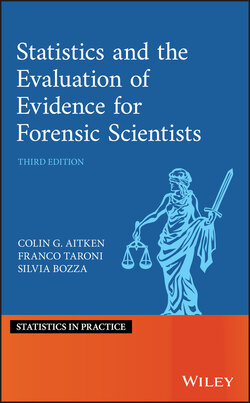Читать книгу Statistics and the Evaluation of Evidence for Forensic Scientists - Franco Taroni - Страница 29
1.7.4 Classical and Frequentist Definitions of Probability and Their Limitations
ОглавлениеThe classical definition of probability defines it as the ratio of the number of favourable cases to the total number of possible cases, provided that all cases are equally probable. There is an obvious circularity to this definition. The statement does not define probability, it only offers a way by which it may be evaluated.
The frequentist definition of probability is the limit of the relative frequency of a target event that has occurred in a large number of trials, as the number of trials increases to infinity, with the important and unrealistic assumption that the trials are repeated under identical conditions. This definition limits the range of applications since if frequency is to be used as a measure of probability, it must be possible to repeat the underlying experiment a large number of times under identical conditions. Consider a scenario in which a coin is tossed. This definition of probability is equivalent to the assessment of the probability of a head (or tail) by imagining that the act of tossing a coin is able to be repeated a large number of times under identical conditions (e.g. with the same force). The number of heads is observed and the ratio of heads to the total number of tosses is taken as an estimate of the probability of a head for that coin. The frequentist definition of probability is inconceivable operationally for applications in forensic science. A well‐known challenge to the frequentist view in the context of criminal law is given by Lindley (1991).
There is nothing wrong with the frequency interpretation or chance. It has not been used in this treatment because it is often useless. What is the chance that the defendant is guilty? Are we to imagine a sequence of trials in which the judgements, ‘guilty’ or ‘not guilty’, are made and the frequency of the former found? It will not work because it confuses the judgement of guilt, but, more importantly, because it is impossible to conceive of a suitable sequence. Do we repeat the same trial with a different jury; or with the same jury bur different lawyers; or do we take all Scottish trials; or only Scottish trials for the same offence? The whole idea of chance is preposterous in this context. (p. 48)
The example makes clear that a definition of probability based on the long‐run relative frequency of an event is inapplicable in many situations arising in real life. There are implicit assumptions that must apply in each of the classical and frequentist definitions. These assumptions are, first, that according to our state of knowledge, all cases are equally likely, and, second, that it is theoretically possible to perform an experiment a large number of times under identical conditions. Use of these assumptions to assign a numerical value to a probability implies a judgement that these assumptions are satisfied. A definition of probability that seeks to avoid subjectivity is based on an acceptance of assumptions that are inherently subjective. The frequentist view presumes the possibility of the performance of a long sequence of experiments under identical conditions, with each experiment being physically independent of all other experiments. These assumptions are typically unachievable in many different applied contexts such as history, law, economics, medicine, and, especially, forensic science. In these contexts, the events of interest are usually not the result of repetitive or replicable processes. On the contrary, they are unique.
This aspect has been explicitly underlined by Kingston and Kirk (1964) in the area of forensic science. The authors wrote:
There are many philosophically oriented fundamental ideas of probability. Perhaps the most practical basic approach to the subject lies in the concept of frequency, in which statements of probability express the relative frequencies of repeated events. [ ] For practical use in criminalistics, it is of little interest what might happen in a long series of trials; the crime is committed only once. Of what use, then, is the above frequency concept? The answer to this lies in another way of looking at probability, which is to consider it as a degree of belief. (p. 514)
Such complications do not arise with the subjective interpretation of probability because that interpretation does not consider probability as a feature of the external world. Instead probability is understood as a notion that describes the relationship between a person (e.g. You, the reader) who makes a statement of uncertainty and the real world to which that statement relates and in which the person acts. With the subjective concept of probability, it is therefore very reasonable to assign a probability to events that are not repeatable, for example, as in a given judicial context. An extended discussion on the limitations of the classical and frequentist definitions of probability can be found in Taroni et al. (2018).
